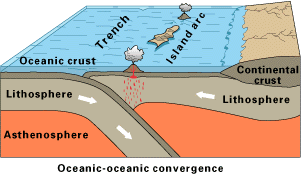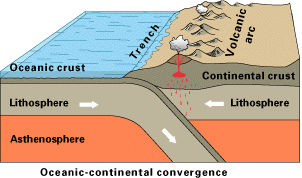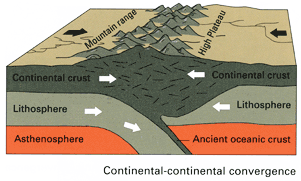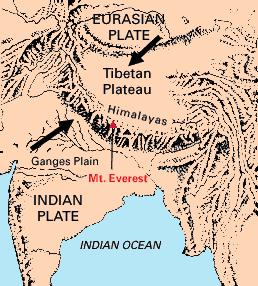 STAGE 1 - Subduction produces partial melting and the formation of a chain of volcanoes = island arc
STAGE 1 - Subduction produces partial melting and the formation of a chain of volcanoes = island arcSTAGE 2 - Build up of intrusive and extrusive igneous material, mixed with sediments, forms larger material
STAGE 3 - The island chain joins up and sediments form an accretionary wedge or prism which builds on to the fore arc area
When the plates collide, one is usually slightly denser than the other, or one is moving slightly faster then the other, so subduction occurs. Consequential subduction and its appending processes are much the same as with oceanic vs continental convergence. When volcanoes erupt islands can form and they usually form characteristically curving lines of new volcanic land (island arcs), with deep trenches. They islands can evolve over millions of years to form major landmasses, like Japan and Indonesia.
Hazards
- Volcanoes = wide cariety of typesm explosive and effusive
- Earthquakes = can be very powerful such as in Indonesia in 2004
- Tidal waves = offshore earthquakes generates waves and the steep islands often suffer inundation, the other cause is collapse of oceanic islands i.e Stromboli
Oceanic vs Continental
 STAGE 1 - Weight of continental sediment causes subsidence of the crust
STAGE 1 - Weight of continental sediment causes subsidence of the crustSTAGE 2 - Subduction develops and an island arc forms
STAGE 3 + 4 - Compression from plate movement cause the crust to thicken and shorten through folding and thrust faulting. Fold mountain chains are formed i.e the Andes
- Mount St Helens was formed in this way, the Cascades represent the curved line of volcanoes jusr inland on the Western Seaboard
- Thicker the crust the more explosive the volcano is
Oceanic crust is denser than continental crust so when they collide the oceanic crust is subducted. As oceanic crust descends, friction with the overlying crust builds up, generating powerful shallow-to-deep focus earthquakes that chart the descent of subducting crust. Rocks scraped off the descending plate and folding of continental crust aids fold mountain formation, whereas deep trenches form along the seaward edge of convergent boundaries. Friction generated by subduction processes generates lots of heat that enables partial melting of the crust. Consequently magmas derived from here are less dense than the mantle so it rises up through fissures until it reaches the surface. This magma is also silica enriched, therefore more viscous, hence the explosive volcanic eruptions and presence of intrusions like batholiths.
Hazards
- Very explosive volcanoes i.e Mount St Helens and Popacatepetl
Structure of Subduction Zones
- The shallower the angle of subduction, the greater the Benioff zone, therefore earthquakes can be felt over a larger area. This means it is better/safer to live in an area with a greater angle of subduction.
Characteristics of Subduction Zones
- Trenches - generally 5-8km deep, although Mariana Trench is 11km
- Belt of earthquakes with the shallowest experienced closest to the trench
- Island arcs (archipelago) form, which are usually curved i.e the Aleutian Islands
Continental vs Continental
 --> This is the process of mountain building as it often reffered to as ab Orogeny, and the moutains as Orogenic Belts
--> This is the process of mountain building as it often reffered to as ab Orogeny, and the moutains as Orogenic Belts- We are currently in the Himalayan orogeny, where the process of continental collision is still active today
 - Over the last 100ma, India has moved northwards. The Himalayan orogeny started well below the equator where an ocean existed to its north called Tethys. The subduction of the oceanic lithosphere thickened the plate to 100km and forced up the fold mountains.
- Over the last 100ma, India has moved northwards. The Himalayan orogeny started well below the equator where an ocean existed to its north called Tethys. The subduction of the oceanic lithosphere thickened the plate to 100km and forced up the fold mountains. Continental plates have similar densities and their buoyancy means no subduction occurs. Instead, they are associated with orogeny. Volcanics associated with earlier subduction and sediments scraped off the vanishing ocean floor are mixed up and compressed to form young fold mountain chains with deep roots in the lithosphere.
Hazards
- Plate has moved very rapidly (200mm/yr)
- Earthquakes occur often
- Crust is too thick for diapirs of magma to make it to the surface so there are no volcanoes
- Mass movement


Hi Vicki, would you mind if I used your blog posts on plate boundaries to create some revision sheets for my A-level students? they're great!! Thanks =)
ReplyDeleteOf course you can - it is nice to know that they are helpful!!!
Delete